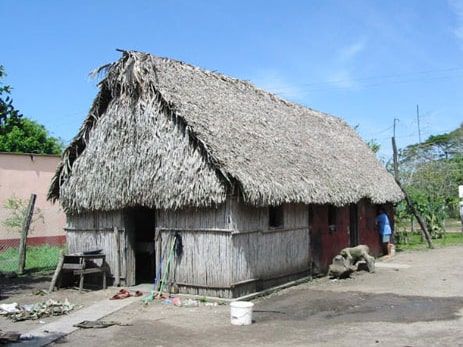What is rural housing like in the Mexican tropics?
Looking at the overall picture, it is easy to imagine the great challenges faced in rural areas to solve, among others, the housing problem. This is a broad outline of the typical construction procedure of rural housing in Tabasco at the beginning of the century, which persists to this day.

It is the intention of this article to show the reader a panoramic view of rural housing in the Mexican tropics, not from a technical approach, but as a sample of the undeniable artisan capacity and the transmission of these skills through generations, which constitutes an invaluable cultural heritage.
The setting is the Mexican tropic and specifically in the state of Tabasco, a state located in the Mexican Southeast, bordering the states of Veracruz, Chiapas, Campeche, and the Gulf of Mexico, and as has been established, the reading is presented in a common language, using in most cases the regional name of the materials used in the construction of housing, avoiding technical terminology, because although this sacrifices accuracy, a more agile and enjoyable description is achieved.
Some information about the region
To achieve a better understanding of the Tabasco rural scenario at the beginning of the century, we must remember that it was not until the 1950s that the state of Tabasco was linked by land with the rest of the country; Until then, communications in the area were basically fluvial and maritime, with the consequent difficulties that this entailed for all kinds of transportation.
To this, we should add that Tabasco is one of the states with the highest rainfall in the country; to get an idea of this, suffice it to say that in some areas of the state it can rain in a period of 24 hours, the same amount as in a whole year in some northern states of Mexico.
Considering the above panorama as a whole, it is easy to imagine the great challenges faced in rural areas to solve, among others, the housing problem. The following is a broad outline of the typical construction procedure of rural housing in Tabasco at the beginning of the century, which persists to this day.
Procedure for construction
The first step consists of choosing the materials that form, so to speak, the framework or skeleton of the house. For this, there are several alternatives such as the tropical woods called tinto, cocohite or chipilcoy, typical of the area. Here, in this stage, the secret consists of using the heart or center of the described woods to make - based on machete - the columns or pillars of the house, since the experience indicates that these materials are those that better resist the humidity when being buried in the ground.
Subsequently, the columns are joined with another type of wood called tatuan, forming what we now call beams or girders; this procedure is carried out starting from the column or pillar and rising towards the center, forming gable or hipped frames, or even circular. Once the above is finished, the beams are joined with stringers made with the same tatuan, which completes the base of the roof or ceiling The ceiling is built using the branches of some varieties of palm trees and is popularly known as guano. Its placement is done by simply intertwining or weaving the material and fastening it to the stringers with knots or ties.
The walls of the house are made of jahuacte, which is a kind of cane very resistant and abundant in the Tabasco environment, and its placement is done with simple moorings using bejuco, which must be previously soaked to soften it, a procedure that according to popular belief, should be carried out during the waning quarter of the moon, to avoid its mothiness.
This stage concludes in what in modern terminology we could call "obra negra" ("rough work") and the house is ready to be inhabited. However, in some cases, after the previous stages, a kind of plaster is applied to the jahuacte walls, with a mixture of common earth, manure, and water, which completely seals the walls, preventing the passage of water and -above all-the mosquito, so abundant in the tropics.
Likewise, and in case a greater firmness is desired in the floor of the house, ash is spread on it, and, adding a little humidity, a magnificent consistency and firmness is achieved. As for the construction time, once the materials have been selected and placed on-site, it is possible to carry out the described process in the lapse of one week, using between four and six workers. Mexican experience has shown us that such houses can exceed 50 years while remaining in good condition.
Tropical housing, a cultural legacy
On the other hand, as can be seen in the described procedure, the classic manufactured materials of construction (steel, cement, nails, wires, etc.) are not used at all, and if we add to this the total absence of tools, except for the machete, we can conclude that the mentioned housing is the product of the teaching transmitted through generations and of the imagination and unquestionable skill of the Mexican artisan.
It is therefore worth noting that these traditions and legacies that exist throughout the length and breadth of the Mexican Republic are part of the cultural heritage and roots that no nation can do without, and for whose preservation and reaffirmation we are all responsible.
By José Ángel Valenzuela Arroyo




